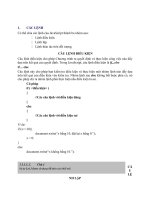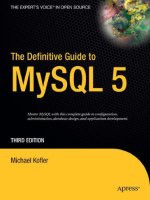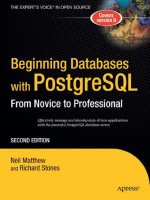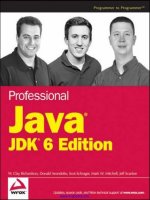professional java, jdk 5 ed 2005
Bạn đang xem bản rút gọn của tài liệu. Xem và tải ngay bản đầy đủ của tài liệu tại đây (11.51 MB, 747 trang )
Professional Java™, JDK™ 5 Edition
W. Clay Richardson
Donald Avondolio
Joe Vitale
Scot Schrager
Mark W. Mitchell
Jeff Scanlon
01_574868 ffirs.qxd 12/21/04 5:51 PM Page iii
01_574868 ffirs.qxd 12/21/04 5:51 PM Page ii
Professional Java™, JDK™ 5 Edition
01_574868 ffirs.qxd 12/21/04 5:51 PM Page i
01_574868 ffirs.qxd 12/21/04 5:51 PM Page ii
Professional Java™, JDK™ 5 Edition
W. Clay Richardson
Donald Avondolio
Joe Vitale
Scot Schrager
Mark W. Mitchell
Jeff Scanlon
01_574868 ffirs.qxd 12/21/04 5:51 PM Page iii
Professional Java™, JDK™ 5 Edition
Published by
Wiley Publishing, Inc.
10475 Crosspoint Boulevard
Indianapolis, IN 46256-5774
www.wiley.com
Copyright © 2005 by John Wiley & Sons, Inc. All rights reserved.
Published simultaneously in Canada
ISBN: 0-7645-7486-8
Manufactured in the United States of America
10 9 8 7 6 5 4 3 2 1
1MA/RR/QR/QV/IN
No part of this publication may be reproduced, stored in a retrieval system, or transmitted in any form
or by any means, electronic, mechanical, photocopying, recording, scanning, or otherwise, except as
permitted under Sections 107 or 108 of the 1976 United States Copyright Act, without either the prior
written permission of the Publisher, or authorization through payment of the appropriate per-copy fee
to the Copyright Clearance Center, 222 Rosewood Drive, Danvers, MA 01923, (978) 750-8400, fax (978)
646-8600. Requests to the Publisher for permission should be addressed to the Legal Department,
Wiley Publishing, Inc., 10475 Crosspoint Blvd., Indianapolis, IN 46256, (317) 572-3447, fax (317) 572-4355,
e-mail:
LIMIT OF LIABILITY/DISCLAIMER OF WARRANTY: THE PUBLISHER AND THE AUTHOR MAKE NO
REPRESENTATIONS OR WARRANTIES WITH RESPECT TO THE ACCURACY OR COMPLETENESS OF
THE CONTENTS OF THIS WORK AND SPECIFICALLY DISCLAIM ALL WARRANTIES, INCLUDING
WITHOUT LIMITATION WARRANTIES OF FITNESS FOR A PARTICULAR PURPOSE. NO WARRANTY
MAY BE CREATED OR EXTENDED BY SALES OR PROMOTIONAL MATERIALS. THE ADVICE AND
STRATEGIES CONTAINED HEREIN MAY NOT BE SUITABLE FOR EVERY SITUATION. THIS WORK IS
SOLD WITH THE UNDERSTANDING THAT THE PUBLISHER IS NOT ENGAGED IN RENDERING LEGAL,
ACCOUNTING, OR OTHER PROFESSIONAL SERVICES. IF PROFESSIONAL ASSISTANCE IS REQUIRED,
THE SERVICES OF A COMPETENT PROFESSIONAL PERSON SHOULD BE SOUGHT. NEITHER THE PUB-
LISHER NOR THE AUTHOR SHALL BE LIABLE FOR DAMAGES ARISING HEREFROM. THE FACT THAT
AN ORGANIZATION OR WEB SITE IS REFERRED TO IN THIS WORK AS A CITATION AND/OR A POTEN-
TIAL SOURCE OF FURTHER INFORMATION DOES NOT MEAN THAT THE AUTHOR OR THE PUB-
LISHER ENDORSES THE INFORMATION THE ORGANIZATION OR WEB SITE MAY PROVIDE OR
RECOMMENDATIONS IT MAY MAKE. FURTHER, READERS SHOULD BE AWARE THAT INTERNET WEB
SITES LISTED IN THIS WORK MAY HAVE CHANGED OR DISAPPEARED BETWEEN WHEN THIS WORK
WAS WRITTEN AND WHEN IT IS READ.
For general information on our other products and services please contact our Customer Care Depart-
ment within the United States at (800) 762-2974, outside the United States at (317) 572-3993, or fax
(317) 572-4002.
Wiley also publishes its books in a variety of electronic formats. Some content that appears in print may
not be available in electronic books.
Library of Congress Cataloging-in-Publication Data
Professional Java, JDK 5 Edition / W. Clay Richardson . . . [et al.].—
p. cm.
Includes bibliographical references and index.
ISBN 0-7645-7486-8 (paper/web site)
1. Java (Computer program language) I. Richardson, W. Clay, 1976-
QA76.73.J38P7623 2004
005.13'3—dc22
2004022626
Trademarks: Wiley and the Wiley Publishing logo are trademarks or registered trademarks of John Wiley
& Sons, Inc. and/or its affiliates. Java is a trademark of Sun Microsystems, Inc. All other trademarks are
the property of their respective owners. Wiley Publishing, Inc., is not associated with any product or ven-
dor mentioned in this book.
01_574868 ffirs.qxd 12/21/04 5:51 PM Page iv
About the Authors
W. Clay Richardson is a software consultant concentrating on agile Java solutions for highly specialized
business processes. He has fielded many Java solutions, serving in roles including senior architect,
development lead, and program manager. He is a coauthor of More Java Pitfalls and Professional Portal
Development with Open Source Tools (Wiley). As an adjunct professor of computer science for Virginia
Tech, Richardson teaches graduate-level coursework in object-oriented development with Java. He holds
degrees from Virginia Tech and the Virginia Military Institute.
Donald Avondolio is a software consultant with over 19 years of experience developing and deploying
enterprise applications. He began his career in the aerospace industry developing programs for flight
simulators and later became an independent contractor, crafting health-care middleware and low-level
device drivers for an assortment of mechanical devices. Most recently, he has built e-commerce applica-
tions for numerous high-profile companies, including The Home Depot, Federal Computer Week, the
U.S. Postal Service, and General Electric. He is currently a technical architect and developer on several
portal deployments. Don serves as an adjunct professor at Virginia Tech, where he teaches progressive
object-oriented design and development methodologies, with an emphasis on patterns.
Joe Vitale has been working as a developer for the last ten years. He has worked significantly with the
latest Java technologies and also the most-popular open source technologies on the market. Besides
being a developer, Vitale is coauthor of Professional Portal Development with Open Source Tools (Wiley),
which had a strong focus on open source development and the Java Portlet API formally known as JSR
168. Joe currently works for McDonald Bradley as a development manager, where he manages more
than 50 developers.
Scot Schrager has consulted extensively in the domains of pharmaceuticals, supply chain management,
and the national security market. He has led and participated in various project teams using Java and
Object Oriented Analysis & Design techniques. Most recently, Schrager has been focused on distributed
application architecture using J2EE technology.
Mark W. Mitchell has extensive experience in enterprise application integration, particularly Web
Services integration between Java and the Microsoft platform. He has developed and deployed several
mission-critical Web applications. Mitchell holds a degree in computer science from the University of
Virginia.
Jeff Scanlon is a senior software engineer at McDonald Bradley in Herndon, Virginia. Scanlon holds
both the Sun Certified Java Developer and Microsoft Certified Solutions Developer certifications and has
been published in Software Development magazine.
01_574868 ffirs.qxd 12/21/04 5:51 PM Page v
Credits
Executive Editor
Robert Elliott
Development Editor
Eileen Bien Calabro
Technical Editor
Dreamtech
Production Editor
William A. Barton
Copy Editor
Luann Rouff
Editorial Manager
Kathryn A. Malm
Vice President and Executive Group Publisher
Richard Swadley
Vice President and Publisher
Joseph B. Wikert
Executive Editorial Director
Mary Bednarek
Project Coordinator
Erin Smith
Graphics and Production Specialists
Beth Brooks
Amanda Carter
Sean Decker
Kelly Emkow
Lauren Goddard
Denny Hager
Joyce Haughey
Jennifer Heleine
Barry Offringa
Quality Control Technicians
John Greenough
Susan Moritz
Media Development Specialist
Angie Denny
Text Design and Composition
Wiley Composition Services
Proofreading and Indexing
TECHBOOKS Production Services
01_574868 ffirs.qxd 12/21/04 5:51 PM Page vi
This book is dedicated to all those who make the daily sacrifices,
especially those who have made the ultimate sacrifice, to ensure our
freedom and security.
01_574868 ffirs.qxd 12/21/04 5:51 PM Page vii
01_574868 ffirs.qxd 12/21/04 5:51 PM Page viii
Acknowledgments
First, I could not have had any chance of actually getting this book done without the support of my
wonderful wife, Alicia. She and my daughter Jennifer, who has far less sophisticated expectations from
my literary skills, are the joy in my life, and I look forward to spending more time with them. I love both
of you more than words can describe. Stephanie, we love you and will never forget you. My fellow
authors—Donnie, Mark, Scot, Jeff, and Joe—have been terrific with their hard work on a demanding
project. I appreciate each of your contributions to this book. I would like to thank Bob Elliott and Eileen
Bien Calabro for all of their hard work and perseverance working with us on this project. I would like to
acknowledge my leadership, Joe Duffy, Jim Moorhead, Don Heginbotham, Tom Eger, Mark Cramer, Jon
Grasmeder, and Doug Dillingham, for their dedication to the simple concept of doing the right thing for
the right people. It is very refreshing to work at a company that exercises the inverse of the cynical “zero
sum game.” I would like to thank my parents, Bill and Kay, my in-laws, Stephen and Elaine Mellman,
my sister Kari, my brother Morgan, and my stepfather Dave for always being there. I would like to
acknowledge my grandmothers, Vivian and Sophie, for being what grandmothers should be.
I would also like to acknowledge my team members for the great things they do every day to make the
world a better place: Jon Simasek, Rob Brown, Keith Berman, Mauro Marcellino, Terry Trepel, Marshall
Sayen, Joe Sayen, Hanchol Do, Greg Scheyer, Scot Schrager, Don Avondolio, and Mark (Mojo) Mitchell.
To my duty crew at the Gainesville District VFD: Bob Nowlen, Gary Sprifke, Patrick Vaughn, Seth
Bowie, Matt Tyrrell, and Gerry Clemente—we have been through a lot together! To Kevin Smith, I think
you were smart to pass on writing to spend more time with Isabella—I think I will do the same with
Jennifer. Matt Tyrrell, I thought about giving you a hard time again this time around but decided not to
tempt fate too much, so I will just remark the obvious—you are still like a brother to me.—WCR
First, I’d like to thank all of my BV pals: Wendong Wang, Arun Singh, Shawn Sherman, Henry Zhang,
Bin Li, Feng Peng, Henry Chang., Sanath Shetty, Prabahkar Ramakrishnan, Yuanlin Shi, Andy Zhang,
and John Zhang. Additionally, I’d also like to thank these people for inspiring me in the workplace:
Swati Gupta, Chi Louong, Bill Hickey, and Chiming Huang. Thanks to all of the great professors at the
Virginia Tech Computer Science/Information Technology Departments: Shawn Bohner, Tarun Sen,
Stephen Edwards, and John Viega. I am indebted to all of my students who taught me so much with
their dedication, hard work, and insight, which has allowed me to incorporate their development wis-
dom for instruction in this book. Appreciation goes out to the sponsors and organizers of The Great Cow
Harbor Run (Northport, New York) and The Columbia Triathlon (Columbia, Maryland) for organizing
world-class events I like to participate in, but more importantly for inspiring me to be a more disciplined
and focused person.
Finally, I wish to thank all of the coauthors, who are fun guys to work with and be around: Joe, Jeff,
Mark, Scot, and Clay; and my co-workers: Mauro Marcellino, Joe and Marshall Sayen, Jon Simasek,
Terry Trepel, Hanchol Do, Keith Berman, and Rob Brown. To all of my family: Mom, Dad, Michael, John,
Patricia, Kiel, Jim, Sue, Reenie, Donna, Kelly, Stephen, Emily, Jack, and Gillian, Matt and Danielle, you
guys are great. To my wife Van, who I love more than anything for her continual support during the
writing of this book.—DJA
01_574868 ffirs.qxd 12/21/04 5:51 PM Page ix
x
Acknowledgments
First, I’d like to thank my wife Jennifer Vitale and my son Andrew. They have been so supportive
throughout my book-writing adventures, and without their encouragement I would not have found the
time or energy to complete this task. I’d also like to thank my grandfather and grandmother Carlo and
Annette Vitale, as well as my father Joseph Vitale, my stepmother Linda Vitale, and my father- and
mother-in-law James and Marlaine Moore. Many thanks also go to John Carver, Brandon Vient, and
Aron Lee for their great supporting roles as friends. Finally, I’d like to thank all of my co-workers at
McDonald Bradley, including Kyle Rice, Danny Proko, Joe Broussard, Rebecca Smith, Joe Cook, Ken
Pratt, Adam Dean, Joon Lee, Adam Silver, John Johnson, Keith Bohnenberger, Bill Vitucci, Barry
Edmond, Arnold Voketaitis, Steven Brockman, Peter Len, Ken Bartee, Dave Shuping, John Sutton,
William Babilon, and many others who have been very supportive. And a special thanks goes to my
coauthors for all of their hard work and encouragement. Thank you all!—JV
I would like to dedicate my contribution of this book to the memory of my father. My biggest fan—I
know he would have put a copy of this book in the hand of everyone he knew. I appreciate the opportu-
nities I have had as the result of the hard work and sacrifice of both of my parents.
I would like to thank my colleagues for helping me be part of this book. I would especially like to thank
Clay and Donnie for their guidance. You make the very difficult seem easy.
This was my first participation in a technical book. I would like to thank my beautiful wife, Heather, for
helping me stay the course. I could not have done it without you.
I would also like to thank Don Schaefer. It has been a privilege to work with you. You have taught me
several lessons firsthand on leadership, professionalism, and conviction. I learned from you that the
quality of a person’s ideas should be judged independent of their position in a company.
One of my early mentors was my high school computer science teacher, Mr. John Nadig. I remember
specifically having some trouble with an assignment. Instead of just telling me the correct answer,
he handed me a thick reference book and said with confidence, “I’m sure you will find the answer in
here.” Thank you for getting me hooked on solving problems; I have been using that approach ever
since.—SRS
I would like to thank my parents: my mother for teaching me how to write and showing me by her
example how to work diligently and persistently through any problem and my father for introducing
me to computer science and programming very early in my life. I would sit by his side and watch him
program and through his patience learned quite a bit—sparking my interest for what would later
become my career. I would like to thank the people I work with right now, and whom I have worked
with in the past. I have learned a lot simply through watching and listening. There is no greater work
atmosphere than the one where you are the least senior—there is something to be learned from every-
one, each and every day of the week. I would like to thank my friends for understanding why I was
always busy around book deadlines and for continuing to support me even as I became a hermit. Most
of all I would like to thank God, as writing this book has been an exercise in faith and trust. Last, but cer-
tainly not least, I would like to thank my ever-loving and supporting fiancée, without whose support I
certainly would not have been able to complete my chapters. Thank you for planning our wedding and
for being patient with me during my many hours of writing. I promise I will spend more time with the
wedding planning!—MWM
I would like to thank the people who made this book possible: Dave Nelson for introducing me to the
world of software development and for being my long-standing friend; Joe Vitale for his friendship and
01_574868 ffirs.qxd 12/21/04 5:51 PM Page x
xi
Acknowledgments
involving me with this book; and Eileen Bien Calabro for working with us as a developmental editor,
helping to ensure that this book succeeds. I would also like to thank those who offer their support and
belief in me—my parents, my family, Phil Bickel, Eric Anderton, John Tarcza, Joseph Kapp, Mark
Orletsky, Gwynne Sayres, Keith Obenschain, Robert Burtt, Myke Weiskopf, Randy Nguyen, Randy
Shine, James Kwon, David Hu, Sung Kwak, Tim Weber, Bobby Suh, Albert Young, Jacob Kim, and a few
others I am sure I am forgetting who stand by me.—JS
01_574868 ffirs.qxd 12/21/04 5:51 PM Page xi
01_574868 ffirs.qxd 12/21/04 5:51 PM Page xii
Contents
Acknowledgments ix
Introduction xxv
Chapter 1: Key Java Language Features and Libraries 1
New Language Features 1
Generics 2
Generic Types and Defining Generic Classes 3
Using Generics 5
Enhanced for Loop 7
Additions to the Java Class Library 8
Variable Arguments 9
Boxing/Unboxing Conversions 11
Unboxing Conversions 12
Valid Contexts for Boxing/Unboxing Conversions 12
Static Imports 13
Enumerations 15
Meta data 17
AnnotationDesc 20
AnnotationDesc.ElementValuePair 21
AnnotationTypeDoc 21
AnnotationTypeElementDoc 21
AnnotationValue 22
Important Java Utility Libraries 26
Java Logging 26
The Log Manager 28
The Logger Class 30
The LogRecord Class 34
The Level Class 37
The Handler Class 38
The Formatter Class 44
Stock Formatters 45
The Filter Interface 48
The ErrorManager 49
Logging Examples 49
Regular Expressions 53
The Pattern Class 58
02_574868 ftoc.qxd 12/21/04 5:53 PM Page xiii
xiv
Contents
The Matcher Class 59
The MatchResult Interface 61
Regular Expression Example 61
Java Preferences 63
The Preference Class 63
Exporting to XML 68
Using Preferences 69
Summary 71
Chapter 2: Tools and Techniques for Developing Java Solutions 73
Principles of Quality Software Development 74
Habits of Effective Software Development 75
Communicate 75
Model 75
Be Agile 75
Be Disciplined 76
Trace Your Actions to Need 76
Don’t Be Afraid to Write Code 77
Think of Code as a Design, not a Product 77
Read a LOT! 78
Build Your Process from the Ground Up 78
Manage Your Configuration 78
Unit Test Your Code 79
Continuously Integrate 79
Maintaining Short Iterations 79
Measure What You Accomplished — Indirectly 80
Track Your Issues 81
Development Methodology 82
Waterfall Methodology 82
Unified Process 83
eXtreme Programming 85
Observations on Methodology 86
Practical Development Scenarios 87
Ant 87
Scenario 1 88
Scenario 2 90
Scenario 3 94
Maven 95
JUnit 98
XDoclet 101
JMeter 107
Summary 109
02_574868 ftoc.qxd 12/21/04 5:53 PM Page xiv
xv
Contents
Chapter 3: Exploiting Patterns in Java 111
Why Patterns Are Important 112
Keys to Understanding the Java Programming Language 112
Keys to Understanding Tools Used in Java Development 113
ANT 113
JUnit 113
XDoclet 113
Keys to Developing Effective Java Solutions 113
Develop Common Design Vocabulary 114
Understand the Fundamentals of Design 114
Building Patterns with Design Principles 115
Designing a Single Class 115
Creating an Association between Classes 115
Creating an Interface 117
Creating an Inheritance Loop 117
Important Java Patterns 119
Adapter 119
The Adapter Pattern Is a Collaboration of Four Classes 120
Client 120
Adaptee 121
Adapter 121
Model-View-Controller 122
Scenario 1: Changing to the Model 123
Scenario 2: Refreshing When the Model Changes 123
Scenario 3: Initializing the Application 124
Model 124
View 125
Controller 128
Command 130
Command 130
CommandManager 131
Invoker 131
Strategy 134
Strategy 135
Context 137
Composite 138
Component 139
Leaf 139
Composite 140
Summary 142
02_574868 ftoc.qxd 12/21/04 5:53 PM Page xv
xvi
Contents
Chapter 4: Developing Effective User Interfaces with JFC 143
Layout Managers 144
BorderLayout 144
BoxLayout 151
FlowLayout 161
GridLayout 167
GridBagLayout 177
SpringLayout 183
CardLayout 191
JFrame and JDialog Components 197
Managing Navigation Flows in Swing Applications 214
Summary 221
Chapter 5: Persisting Your Application Using Files 223
Application Data 224
Saving Application Data 225
A Configuration Data Model for the Imager Application 225
Java Serialization: Persisting Object Graphs 228
Key Classes 229
Serializing Your Objects 229
Configuration Example: Saving Your App’s Configuration to Disk 230
Giving Your Application a Time-based License Using Serialization 235
Implementing the License 236
Implementing the Timeserver 238
Tying Your Serialization Components into the Application 239
Extending and Customizing Serialization 243
The Transient Keyword 243
Customizing the Serialization Format 243
Versioning 245
When to Use Java Serialization 247
Java Beans Long-Term Serialization: XMLEncoder/Decoder 248
Design Differences 248
XML: The Serialization Format 249
Key Classes 250
Serializing Your Java Beans 251
Robustness Demonstrated: Changing Configuration’s Internal Data 252
Possible Customization 254
Persistence Delegates 255
When to Use XMLEncoder/Decoder 255
02_574868 ftoc.qxd 12/21/04 5:53 PM Page xvi
xvii
Contents
XML Schema-Based Serialization: Java API for XML Binding (JAXB) 256
Sample XML Document for Your Configuration Object 257
Defining Your XML Format with an XML Schema 259
Defining Your Data: Configuration.xsd 260
Generating JAXB Java Classes from Your Schema 263
Generated JAXB Object Graphs 265
JAXB API Key Classes 269
Marshalling and Unmarshalling XML Data 269
Creating New XML Content with JAXB-Generated Classes 270
Using JAXB-Generated Classes in Your Application 271
Implementing Your Save Action 273
Implementing Your Load Action 275
When to Use JAXB 278
Future Direction of JAXB 2.0 279
Summary 279
Chapter 6: Persisting Your Application Using Databases 281
JDBC API Overview 281
Setting Up Your Environment 283
JDBC API Usage in the Real World 283
Understanding the Two-Tier Model 283
Understanding the Three-Tier Model 284
Grasping JDBC API Concepts 285
Managing Connections 286
DriverManager Class 286
DataSource Interface 286
Understanding Statements 287
Investigating the Statement Interface 288
Exploring the PreparedStatement Interface 289
Exploring the CallableStatement Interface 292
Utilizing Batch Updates 294
Utilizing Result Sets 298
Investigating Types of Result Sets 298
Setting Concurrency of Result Sets 298
Setting Holdability of Result Sets 299
Using Result Sets 299
Examining JDBC Advanced Concepts 302
Managing Database Meta Data 302
Discovering Limitations of a Data Source 303
Determining Which Features a Data Source Supports 303
Retrieving General Information about a Data Source 304
02_574868 ftoc.qxd 12/21/04 5:53 PM Page xvii
xviii
Contents
Utilizing RowSets 308
Understanding RowSet Events 308
RowSet Standard Implementations 308
Using the New JdbcRowSetImpl 309
Connection Pooling 310
Managing Transactions 310
What Is a Transaction? 310
Standard Transactions 311
Distributed Transactions 311
Object to Relational Mapping with Hibernate 312
Exploring Hibernate’s Architecture 312
Supported Database Platforms 314
Plugging Hibernate In 314
Developing with Hibernate 315
Understanding Mappings 315
Setting Hibernate Properties 317
Using Hibernate’s APIs for Persistence 317
Putting It All Together: The Forum Example 320
Summary 327
Chapter 7: Developing Web Applications Using the Model 1 Architecture 329
What Is Model 1? Why Use It? 329
JSP 2.0 Overview 331
Servlet 2.4 Support 332
Expression Language Support 332
Code Reuse with *.tag and *.tagx Files 335
JSP Page Extensions (*.jspx) 336
Simple Invocation Protocol 337
Integrated Expression Language (EL) 339
JSTL 1.1 Overview 340
Function Tag Library 341
SQL Actions 342
Developing Your Web Application Visualizations with JSTL 344
Developing Your Web Application Visualizations with JSP 2.0 350
Summary 364
Chapter 8: Developing Web Applications Using the Model 2 Architecture 365
The Problem 365
What Is Model 2? 365
Why Use Model 2? 367
02_574868 ftoc.qxd 12/21/04 5:53 PM Page xviii
xix
Contents
Developing an Application with WebWork 368
What Is Inversion of Control and Why Is It Useful? 369
Architecture 371
Interceptors 372
ValueStack 373
OGNL 373
Components 374
Extending the Framework to Support Hibernate 374
Preventing the Hanging Session 375
Defining Your Domain Model 378
Implementing Your Use Cases with Actions 384
Developing Your Views 387
Adding Contacts to the System 389
Browsing Contacts 391
Configuring Your Application 394
Adapting to Changes 397
Summary 399
Chapter 9: Interacting with C/C++ Using Java Native Interface 401
A First Look at Java Native Interface 401
Creating the Java Code 402
Creating the Native Code and Library 403
Executing the Code 405
Java Native Interface 406
Data Types 406
Strings in JNI 406
String Example 408
Arrays in JNI 410
Array Functions 411
Array Examples 413
Working with Java Objects in C/C++ 416
Accessing Fields in JNI 416
Invoking Java Methods Using JNI 419
Handling Java Exceptions in Native Code 423
Working with Object References in Native Code 425
Local References 425
Global and Weak Global References 427
Comparing References 429
Advanced Programming Using JNI 429
Java Threading 429
Native NIO Support 430
02_574868 ftoc.qxd 12/21/04 5:53 PM Page xix
xx
Contents
Manually Registering Native Methods 430
Reflection 432
Developing an E-Mail Client 434
System Design 434
User Interface 435
Summary 444
Chapter 10: Communicating between Java Components with RMI and EJB 445
Remote Method Invocation 445
Exploring RMI’s Architecture 446
Developing RMI Applications 448
Using Threads in RMI 448
Using Dynamic Class Loading 449
Distributed Garbage Collection 449
Examining Remote Object Activations 449
TestRemoteInterface Interface 450
TestActivationImpl Class 450
TestClient Class 451
Register Class 452
Starting the Activation Tools 453
RMIChat Example 453
RMIChat Interface 454
RMIChatImpl Class 455
ChatUser Class 459
ChatApplet Class 460
Compiling the RMIChat Application 464
Enterprise JavaBeans 465
EJB Basics 465
Types of EJBs 466
Session Beans 466
Entity 466
Message Driven 466
Examining EJB Containers 467
EJB Loan Calculator Example 468
LoanObject Interface 468
LoanHome Interface 468
LoanBean Class 469
LoanClient Class 470
Examining the EJB-JAR.XML File 473
Summary 475
02_574868 ftoc.qxd 12/21/04 5:53 PM Page xx
xxi
Contents
Chapter 11: Communicating between Java Components and
Components of Other Platforms 477
Component Communication Scenarios 478
News Reader: Automated Web Browsing 478
A Bank Application: An EJB/J2EE Client 478
A Portal: Integrating Heterogeneous Data Sources and Services 478
Overview of Interprocess Communication and Basic Network Architecture 479
Sockets 480
The Java Socket API 481
Key Classes 481
Client Programming 481
Server Programming 482
Putting It All Together: An Echo Server 483
Implementing a Protocol 487
Protocol Specification 488
Proprietary Protocols and Reverse Engineering 498
Utilizing Existing Protocols and Implementations 499
Remote Method Invocation 500
Core RPC/RMI Principles 500
Marshalling and Unmarshalling 501
Protocols 503
RMI Registry 503
Distributed Objects 504
Middleware and J2EE 504
Common Object Request Broker Architecture 505
CORBA Basics 506
IDL: Interface Definition Language 507
ORB: Object Request Broker 509
Common Object Service (COS) Naming 509
IIOP: Internet InterORB Protocol 509
RMI-IIOP: Making RMI Compatible with CORBA 510
How to Turn an RMI Object into an RMI-IIOP Object 510
When to Use CORBA 512
Distributed File System Notifications: An Example CORBA System 513
The Implementation 516
Running the Example 521
Web Services 522
Evolution of the World Wide Web 523
Platform Independent RPC 526
Web Services Description Language (WSDL) 528
Simple Object Access Protocol (SOAP) 529
02_574868 ftoc.qxd 12/21/04 5:53 PM Page xxi
xxii
Contents
Weather Web Site Example 531
The Future 540
Summary 541
Chapter 12: Distributed Processing with JMS and JMX 543
Basic Concepts 544
JMS Fundamentals 544
Sending and Receiving a JMS Message 545
JMX Fundamentals 548
Using Standard MBeans 549
Deploying MBean for Management 550
Using Adaptors and Connectors 551
Building a Distributed Application 551
Deciding on the Message Type 552
Understanding the Three-Component Architecture 553
Creating a Component to Process JMS Messages 553
MessageListener 555
MessageProcessorMBean 555
JndiHelper 556
MessageProcessor 558
Processable 562
OrderProcessor 562
JMXAgent 563
Creating a Component that Directs Messages through the Business Process 564
Routeable 565
MessageRouter 565
Creating a Component to Divide Large Tasks for Parallel Processing 566
Splitable 567
MessageSplitter 567
Aggregateable 570
MessageAggregator 570
OrderAggregator 572
Deploying the Application 573
Basic Deployment 573
Advanced Deployment 578
Deploy the M-Let Service 579
Configure the Deployment Descriptor 579
Add the M-Let Configuration File to the M-Let Service 581
Summary 581
02_574868 ftoc.qxd 12/21/04 5:53 PM Page xxii









